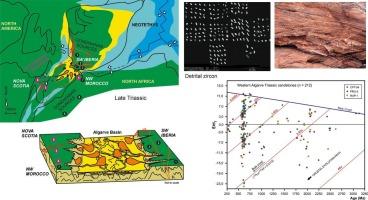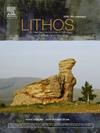U-Pb ages and Hf isotopic composition of detrital zircon in western Algarve Triassic sandstone (SW Iberia): Implications for crustal evolution, provenance, and paleogeography
IF 2.9
2区 地球科学
Q2 GEOCHEMISTRY & GEOPHYSICS
引用次数: 0
Abstract
The Triassic paleogeographic configuration before the Central Atlantic Ocean's opening and the Pangea's breakup establishes that Iberia was close to North America and North Africa. We present U![]() Pb and Hf isotope data of Triassic siliciclastic rocks of the Western Algarve basin (Southwest Iberia, Portugal) to draw inferences on their provenance to define the crustal evolution of the potential sources. Detrital zircon age populations of five samples of Triassic sandstones (68–80 % Neoproterozoic; 5–23 % Paleoproterozoic; 5–14 % Mesoproterozoic; <5 % Archaen and < 4 % Paleozoic) differ significantly from those of the underlying Carboniferous turbidites of the South Portuguese Zone suggesting provenance from outside present-day SW Iberia. Hf isotope signatures of the zircon grains from the western Algarve Triassic sandstones unravel a complex crustal evolution characterized by successive cycles of input of juvenile magmas and magmas derived from the reworking of older crust. Archean detrital zircon grains with positive εHf(t) values and model ages of 3.1–3 Ga indicate juvenile crust formation (Leonian event), while a grain dated at ca. 2.6 Ga showing negative εHf(t) values and model ages of 3.1 Ga suggests that the Archean crust became reworked later (Liberian event). Zircon grains dated between 2.4 and 2.5 Ga having positive to slightly negative εHf(t) values and model ages of 3.3–2.6 Ga model ages correspond to magmatism older than the Eburnean event known in the Reguibat shield, involving a juvenile component mixed with variable proportions of reworked Archean crust. Younger Paleoproterozoic grains (ca. 2.10 to 2.05 Ga; Eburnean-Birimian event) having positive εHf(t) values and model ages of 2.3–2.1 Ga and negative εHf(t) values and model ages of 3.6–2.6 Ga, also indicate interaction of juvenile sources with mixing of old crust. Mesoproterozoic grains show positive εHf(t) values and model ages of 2.3–2.1 Ga, suggesting juvenile crust formation and reworking of the Eburnean crust. Neoproterozoic (ca. 695–555 Ma) detrital zircon with positive εHf(t) values and model ages of 0.76–0.58 Ga point to juvenile crust formation (i.e. Cadomian/Pan-African and Avalonian arcs). They also have negative εHf(t) values in the range − 21.6 to −11.7 and model ages of 3.2–2.1 Ga, suggesting reworking of older crust. In summary, the εHf(t) values and U
Pb and Hf isotope data of Triassic siliciclastic rocks of the Western Algarve basin (Southwest Iberia, Portugal) to draw inferences on their provenance to define the crustal evolution of the potential sources. Detrital zircon age populations of five samples of Triassic sandstones (68–80 % Neoproterozoic; 5–23 % Paleoproterozoic; 5–14 % Mesoproterozoic; <5 % Archaen and < 4 % Paleozoic) differ significantly from those of the underlying Carboniferous turbidites of the South Portuguese Zone suggesting provenance from outside present-day SW Iberia. Hf isotope signatures of the zircon grains from the western Algarve Triassic sandstones unravel a complex crustal evolution characterized by successive cycles of input of juvenile magmas and magmas derived from the reworking of older crust. Archean detrital zircon grains with positive εHf(t) values and model ages of 3.1–3 Ga indicate juvenile crust formation (Leonian event), while a grain dated at ca. 2.6 Ga showing negative εHf(t) values and model ages of 3.1 Ga suggests that the Archean crust became reworked later (Liberian event). Zircon grains dated between 2.4 and 2.5 Ga having positive to slightly negative εHf(t) values and model ages of 3.3–2.6 Ga model ages correspond to magmatism older than the Eburnean event known in the Reguibat shield, involving a juvenile component mixed with variable proportions of reworked Archean crust. Younger Paleoproterozoic grains (ca. 2.10 to 2.05 Ga; Eburnean-Birimian event) having positive εHf(t) values and model ages of 2.3–2.1 Ga and negative εHf(t) values and model ages of 3.6–2.6 Ga, also indicate interaction of juvenile sources with mixing of old crust. Mesoproterozoic grains show positive εHf(t) values and model ages of 2.3–2.1 Ga, suggesting juvenile crust formation and reworking of the Eburnean crust. Neoproterozoic (ca. 695–555 Ma) detrital zircon with positive εHf(t) values and model ages of 0.76–0.58 Ga point to juvenile crust formation (i.e. Cadomian/Pan-African and Avalonian arcs). They also have negative εHf(t) values in the range − 21.6 to −11.7 and model ages of 3.2–2.1 Ga, suggesting reworking of older crust. In summary, the εHf(t) values and U![]() Pb age pattern of the zircon grains from the Triassic siliciclastic rocks are similar to NW Africa and North America potential sources. Still, there is a notable gap in juvenile crust production during the Siderian in the peri-Eastern Laurentia, Avalonia, and Ganderia potential sources unknown in NW Africa. The lack of ca. 525–380 Ma and ca. 380–330 Ma detrital zircon in the western Algarve Triassic sandstones makes it challenging to admit an Atlantic margin of North America and SW Iberia provenance.
Pb age pattern of the zircon grains from the Triassic siliciclastic rocks are similar to NW Africa and North America potential sources. Still, there is a notable gap in juvenile crust production during the Siderian in the peri-Eastern Laurentia, Avalonia, and Ganderia potential sources unknown in NW Africa. The lack of ca. 525–380 Ma and ca. 380–330 Ma detrital zircon in the western Algarve Triassic sandstones makes it challenging to admit an Atlantic margin of North America and SW Iberia provenance.

阿尔加维西部三叠纪砂岩(伊比利亚西南部)中锆石碎片的 U-Pb 年龄和 Hf 同位素组成:对地壳演化、产地和古地理的影响
中大西洋开辟和泛大陆解体之前的三叠纪古地理格局确定了伊比利亚靠近北美洲和北非。我们提供了西阿尔加维盆地(葡萄牙伊比利亚西南部)三叠纪硅质碎屑岩的 UPb 和 Hf 同位素数据,以推断其来源,从而确定潜在来源的地壳演化。五个三叠纪砂岩样本的锆英石年龄群(68-80 % 新新生代;5-23 % 古新生代;5-14 % 中新生代;<5 % 古生代和<4 % 古生代)与南葡萄牙区石炭纪浊积岩下层的锆英石年龄群差异显著,表明其来源于当今伊比利亚西南部以外的地区。阿尔加维西部三叠纪砂岩中锆石颗粒的 Hf 同位素特征揭示了复杂的地壳演化过程,其特点是幼年岩浆和旧地壳再加工产生的岩浆的连续循环输入。具有正εHf(t)值和3.1-3 Ga模型年龄的Archean岩屑锆石颗粒表明地壳是由幼年岩浆形成的(Leonian事件),而一个年代为约2.6 Ga的锆石颗粒显示出负εHf(t)值和3.1 Ga模型年龄,这表明Archean岩壳在后来经过了再加工(Liberian事件)。年代在2.4-2.5 Ga之间的锆石颗粒,其εHf(t)值为正值到轻微的负值,模型年龄为3.3-2.6 Ga,对应于比雷吉巴特盾状区已知的埃伯恩事件更早的岩浆活动,包括混合了幼年成分和不同比例的再造阿切安地壳。较年轻的古近纪岩粒(约 2.10 至 2.05 Ga;埃伯恩-比里曼事件)具有正的εHf(t)值和 2.3 至 2.1 Ga 的模型年龄,以及负的εHf(t)值和 3.6 至 2.6 Ga 的模型年龄,也表明幼生源与旧地壳混合的相互作用。中新生代晶粒显示正的εHf(t)值和2.3-2.1 Ga的模型年龄,表明幼生代地壳的形成和埃伯恩地壳的再加工。新元古代(约695-555Ma)锆英石的εHf(t)值为正,模型年龄为0.76-0.58Ga,表明是幼壳形成(即Cadomian/泛非弧和Avalonian弧)。它们的εHf(t)值在-21.6到-11.7之间,模型年龄为3.2-2.1 Ga,表明是老地壳的再加工。总之,三叠纪硅质碎屑岩锆石晶粒的εHf(t)值和UPb年龄模式与非洲西北部和北美洲的潜在来源相似。然而,在西北非未知的近东劳伦西亚、阿瓦隆尼亚和甘德利亚潜在来源地区,西德纪的幼生地壳生成仍存在明显的差距。阿尔加维西部三叠纪砂岩中缺乏约 525-380 Ma 和约 380-330 Ma 的锆英石,这使得承认北美大西洋边缘和伊比利亚西南部的来源具有挑战性。
本文章由计算机程序翻译,如有差异,请以英文原文为准。
求助全文
约1分钟内获得全文
求助全文
来源期刊

Lithos
地学-地球化学与地球物理
CiteScore
6.80
自引率
11.40%
发文量
286
审稿时长
3.5 months
期刊介绍:
Lithos publishes original research papers on the petrology, geochemistry and petrogenesis of igneous and metamorphic rocks. Papers on mineralogy/mineral physics related to petrology and petrogenetic problems are also welcomed.
 求助内容:
求助内容: 应助结果提醒方式:
应助结果提醒方式:


